This article is dedicated to the memory of my father Col. K .S. Sachidanand (Corps of Engineers Madras Sappers, Indian Army) who left for his heavenly journey on May 27th, 2020 towards the Lotus Feet of the Paramatma
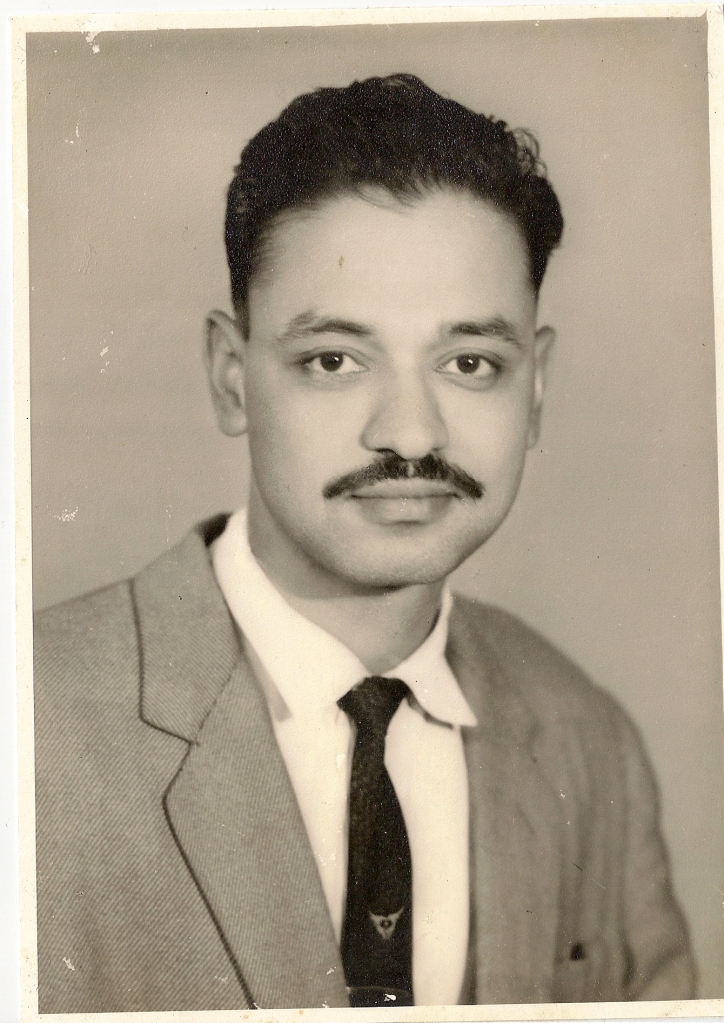
“Punarapi jananam punarapi maranam,
Punarapi janani jatare sayanam,
Iha samsaare bahu dusthare,
Krupayaa pare pahi murare.”
“Bhaja Govindam; Bhaja Govindam”
You would have heard this beautiful bhajan sung by M. S. Subbulakshmi in her divine voice. To translate the verse, it means
“One is born again and again; which means one also dies again and again in a never ending circle of life. You sleep in your mother’s womb in different births and the cycle repeats again and again! O Lord, the vanquisher of Mura the asura (Lord Krishna), Help me cross this limitless Sea of Life.” Bhaja Govindam – Worship Govinda!
These lines are from the profound composition ‘Bhaja Govindam written by Jagad Guru Adi Shankaracharya (788-820 CE).
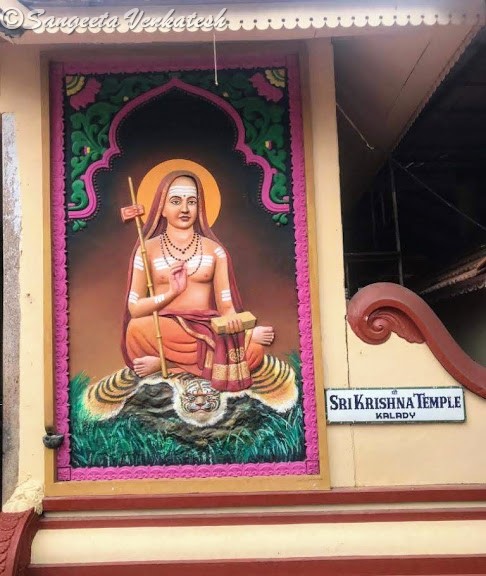
Adi Shankaracharya, was one of the most important philosophers and religious leaders of Sanatana Dharma and is widely revered as a religious reformer. He formulated and codified the Advaita Vedanta philosophy, the non-dualistic system based on the Upanishads. It came at a time when Vedic tenets were threatened by various interpretations that were threatening dharma. It is this Sanatana Dharma that has withstood the travails of time and is unbroken till today.
Adi Shakaracharya was born to a poor brahmin family in Kalady, 34 kilometres from Ernakulam town in Kerala. This was our last leg of the Kochi trip in November 2019, and earlier in the day we had been lucky to attend the Vrischikotsavam at the Poornathrayeesa Temple in Thripunithura. And after an enthralling darshan, we drove to Kalady.
Discovery of Kalady as birthplace of Adi Shankaracharya: I was surprised to learn that Kalady, the birth place of Sri Sankara, remained obscure till the beginning of 20th century. Sri Sachidananda Shivabhinava Narasimha Bharati Swamigal, the 33rd Peethathipati of the illustrious Sringeri Guru Parampara with the help of Sri Molam Thirunal Ramavarma Maharaja of Thiruviatamcore located Kalady. While the Advaita philosophy gave us many answers to life’s questions and dispelled ignorance, the place of birth remained unknown for centuries. It was indeed important to know where great souls were born and raised.
Kalady, is a beautiful hamlet and is located on the northern banks of the Periyar River. The river was earlier known as Poorna – which means completeness, as if to depict Adi Shankara’s philosophies.
His Holines, the 33rd Jagadguru, built two temples for Goddess Sharadambal and one for Sri Shankaracharya and the Kumbhabhishekam (inauguration), was performed on the auspicious day of Magha Shukla Dwadasi in the year 1910. 1200 years ago, Kalady, at the time of Adi Shankara’s birth was a collection of Agraharas- which were centres of learning and culture. He was born to a poor yet pious Namboodri couple Shivaguru and Aryamba. The couple had prayed to Lord Shiva for a progeny at the Vadakkanathar temple near Thrichur. Lord Shiva had appeared in Shivaguru’s dream about Shankara’s birth. It was this child who learned at a gurukul here, exhibit his divine powers and then went on to become a great philosopher and single-handedly revived Sanatana Dharma.
The story goes that Aryamba, after being widowed would walk three kilometres from their home to the River Purna to bathe there. On one day, she fainted and was asked not to walk such distances. Aryamba was disappointed that she could no longer bathe in the river, so the young Shankara prayed to Lord Krishna with tears. Lord Krishna blessed him by saying “The river will flow where your little feet have created the marks”, and the Purna River took a new course towards little Shankara’s house and hence the place is called Kalady (the place where the feet created an impression).
1.Adi Shankara JanmaBhumi Kshetra (Sringeri Math complex): Stepping into the Adi Shankara-Shardambal temple, I could feel the spiritual vibrations of the place. The entrance to the temple is beautiful with the traditional Kerala mural painting on either side of the door with wooden panels in the centre. One of the painting depicts the beautiful story of Shankara when he went begging for alms while he was enrolled in a gurukul.

According to tradition a brahmachari (student) had to go from house to house and collect alms and give it to his guru. On a Dwadasi day Sankara happened to go to the house of a very poor woman and asked for the alms. The woman unfortunately did not have a grain of rice in her house to offer. However, she had kept a single gooseberry for herself as it was a Dwadasi (12th lunar day either waxing or waning) day. She readily offered gave this (Amla fruit) gooseberry to Sankara as she did not want to send a Brahmachari empty handed. Sankara was so moved by her selflessness and also at the poverty of the lady, that he immediately composed a hymn for Goddess Lakshmi- the goddess of wealth. As a he completed this composition, Goddess Lakshmi appeared and showered a rain of golden coins on the poor woman’s house. This stotra or hymn was hence called the Kanakadhara (stream of gold), composed by Shankara when he was just eight years old. Here is a link to the stotra.

In the centre of the entrance door are images of Adi Shankara with his disciples in the centre, the Devi Shardambal on the extreme left as you face the door and the various Shankaracharyas of the Mutt through the ages.

In the large complex Shardamba Devi reside as the Parabrahma Swaroopini in her various avatars, namely, Brahmi, Maheshwari, Varahi, Kaumari, Vaishnavi, Indurani and Chamundi. They are the SaptaMaatrikas or seven mothers. In the same side of the complex is the Samadhi or Brindavana of Aryamba, Shankara’s mother. From the centre, a window gives you a glimpse of the beautiful Purna River and the verdant ghats. On the other side of the hall is the sanctum sanctorum of Lord Ganapati. The vigraha or idol of Ganapati has 10 hands and his trunk is turned to the right side. All over the walls are plaques that tell you inspiring stories of Adi Shankaracharya. The worship in this temple is performed by Tamil or Kannada Smartha Brahmins. Photography is not allowed indoors.

2. The Sri Krishna Temple: We then stepped to visit the Sri Krishna temple that is to the west of the Sringeri Math Complex. This temple is believed to be the ancestral deity of Shankaracharya and perhaps the only surviving structure from the time of Shankara.
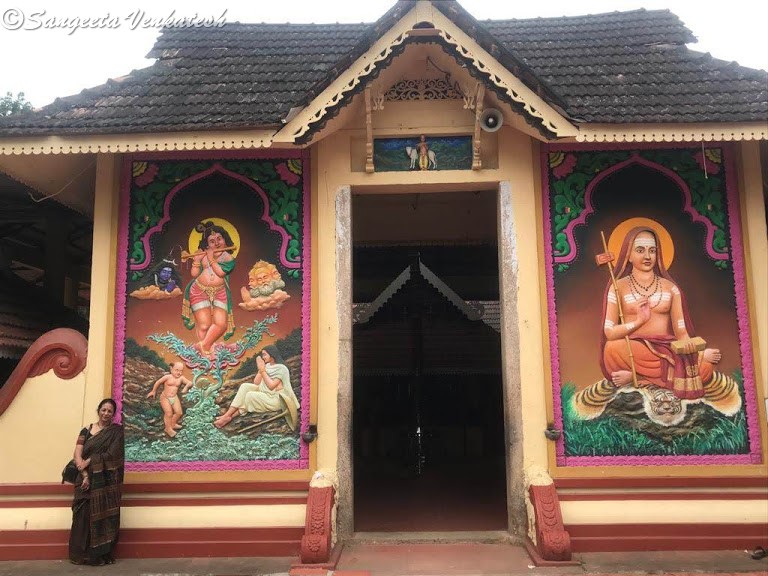
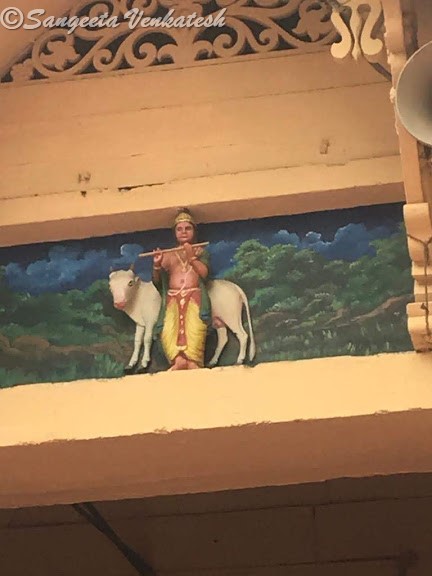
The temple is under Kalady Devasthanam, under the trusteeship of two Namboothiri families who had close associations with the life of Shankara. The worship in this temple is also conducted by Namboothiris. The important event in this temple is Kanakadhara Yagnam, the story of which I have mentioned above.
On the left of the entrance of the temple is a mural of the story of Shankara and the crocodile that got hold of his leg in the river Periyar. Even as a young boy, Shankara contemplated about how kings were at war and there was no unity. He felt that the answer was spiritual unity. To achieve it he wanted to take sanyasa and become a monk. But his mother wouldn’t hear any of it. Shankara did not leave without his mother’s permission and he decided to wait a little longer. One day when Sankara was taking bath in the river, a crocodile caught hold of his leg. Sankara called out to his mother. Aryambal came running and to her horror she found her son in the grip of the crocodile. She didn’t know how to get help. Shankara requested his mother that she give him permission to become a sanyasi as his life was coming to an end and that he wanted to die as a sanyasi. In desperation, Aryambal gave him permission. At that instant the crocodile miraculously left his leg and Shankara came out unscathed. Aryambal understood that Shankara had great tasks ahead of him. And a few days later Shankara left home to search for a guru with a promise to his mother that he would come back when he needed her.

3. A few steps away is the Veda Vedanta Study Centre, which follows the ancient Gurukula system. The Pathshala is over 100 years old and students from the school are spreading the word of their guru across continents.
4. The Banks of the Poorna River:
a. Kalady Kadavu (Aaraattu Kadavu): The Kalady Kadavu is the place where the river took its turn, and where Kalady was born.
b. The “Muthala Kadavu,” or Crocodile Ghat: The above incident is supposed to have taken place by the banks of the Poorna or Periyar river.
c. Ghat of the post-funeral rites of Mother Aryamba: This is the ghat where Shankara performed the Apara Kriyas (the rituals after death and cremation as per Nambudiri rituals) for his mother Aryamba. Today, the ghat is within the temple complex of Sree Sringeri Math.
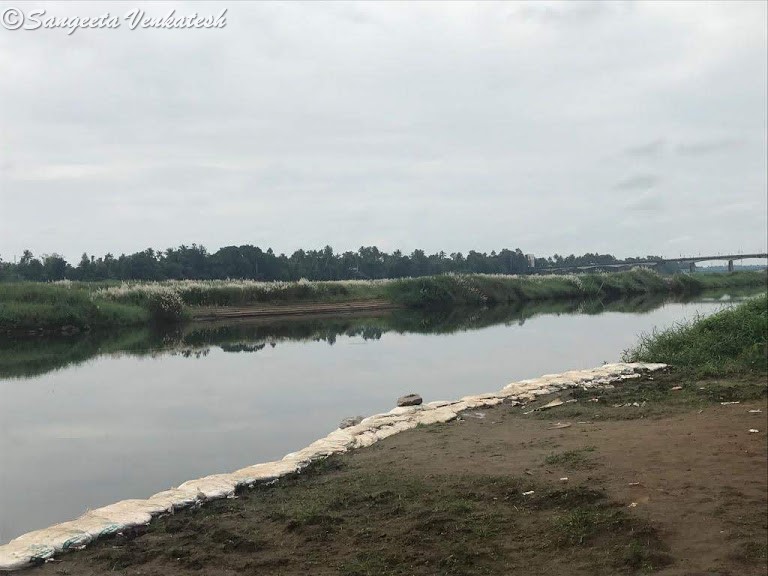

5. Sri Adi Sankara Keerthi Sthamba Mandapam:
A short drive away is the Sri Adi Sankara Keerthi Sthamba Mandapam, which is a nine – storey octogonal tower and is 150 feet tall in height. At the entrance of the building are statues of two elephants that leads to the Paduka Mandapam or the platform where the sandals of Shankaracharya are kept. Two silver knobs represent the padukas, or wooden sandals of the teacher. Each floor is commemorated to a period of Shankaracarya ‘ s life. This was built by the Kanchi Kamakoti Matha. It is a lesson in history as you climb up the stairs of the Mandapam.
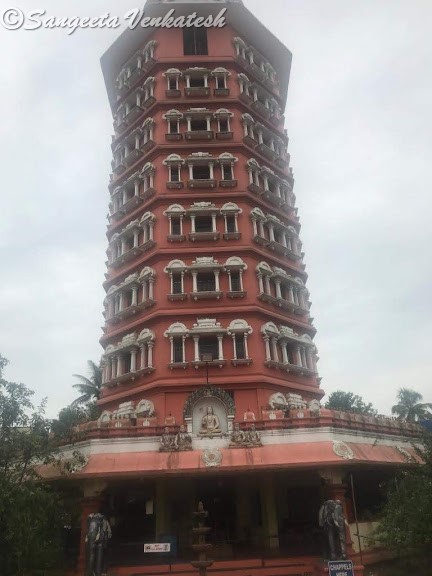
While this giant of a philosopher was born in a humble village of Kalady, his contribution to humankind was of gargantuan proportions. And at age 32 Shankara ended his stupendous earthly mission. To quote Dr. Surendra Patnaik of the Institute of Advance Study of Education, “The advent of Adi Shankara is a landmark event in the history of Indian philosophy and religion and in the personal spiritual evolution of every individual. His teachings reveal the truth of the Supreme Brahman to the sincere seeker. His contribution is beyond imagination; a few of these contributions in the form of commentaries which are treasures to Hindu Sanatana belief.”
These are Vivekachudamani, Atma Bodha, Aparoksh Anubhuti, Ananda Lahari, Atma-Anatma Vivek, Drig-Drishya, Upadesa Sahasri.
My blog will be inadequate to describe the greatness of the Jagadguru and even as I write this piece, I have goosebumps.
The following is a documentary where even the current H H Sringeri Shankaracharya narrates a part of the story.


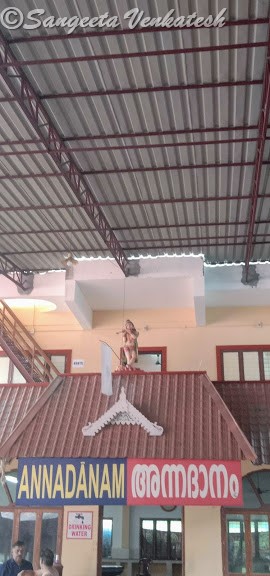

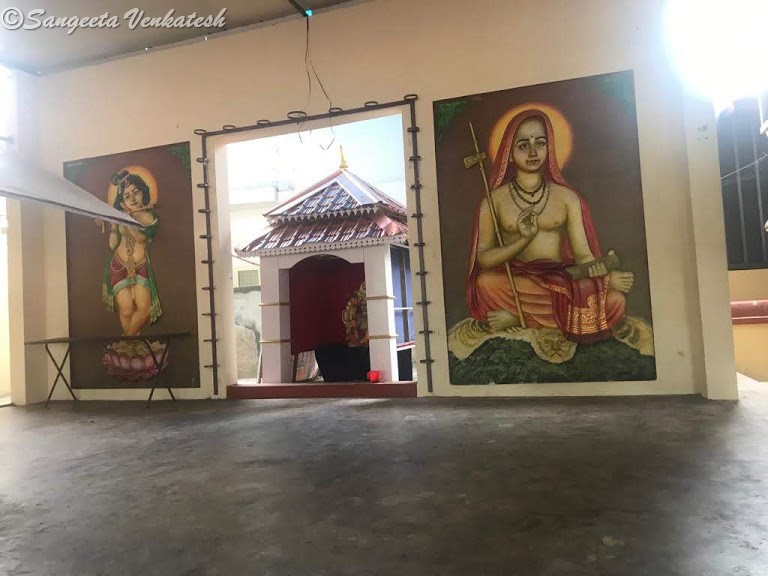
Nice post
LikeLike
Thank you!
LikeLike
Great post 😁
LikeLike
Thank you!
LikeLike
Very nice write-up. I have visited Kalady too. Found it very inspiring. I recognized all the spots in your blog. Shankara was a monumental figure.
LikeLike
Padma, I thought of you while writing this piece! From our last conversation.
LikeLike
Such a fitting tribute to your Dad ,Sangeeta . This is a wonderfully and extensively researched post and so meticulously compiled to the last detail . I loved it ❤️The place is fascinating ..
LikeLike
Thank you so much Priya!
LikeLike
Great post Sangeeta. Now I feel like visiting the place. It is on my bucket list. 😊
LikeLike
God willing Simi- you will!
LikeLike
Thank you!
LikeLike
Pingback: #KarnatakaDiaries; Udupi: Dwaita philosophy, Krishna and beyond ©Sangeeta Venkatesh – sojourn-with-san
Beautiful. It’s a historical values .
LikeLike
Glad you liked it !
LikeLike
Thank you Madam. I am enriched with your post.
LikeLike
Pingback: #Kochi Diaries: Fort Kochi- a medley of cultures©Sangeeta Venkatesh | sojourn-with-san
Pingback: Temples of Bangalore (Rajarajeshwari Nagar) ©Sangeeta Venkatesh | sojourn-with-san